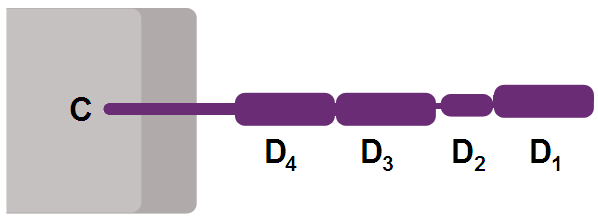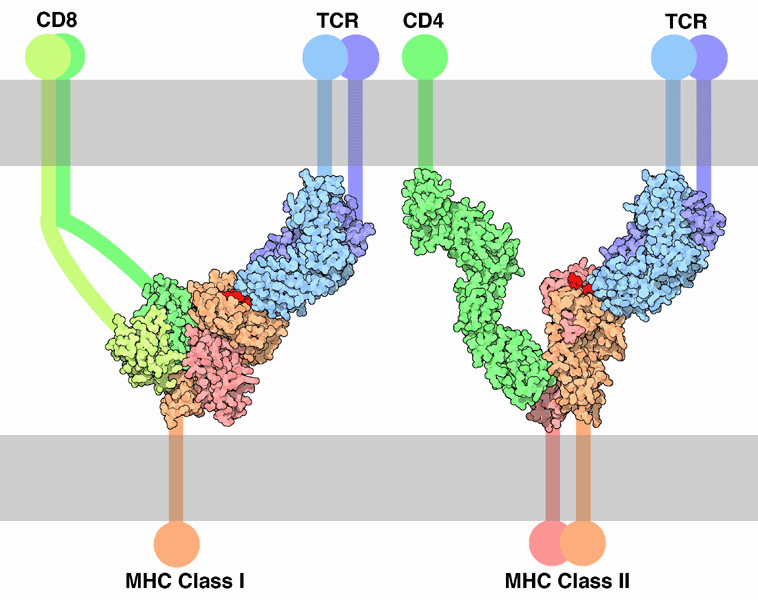CD4
| CD4 molecule | |||
|---|---|---|---|
 PDB rendering based on 1cdh. | |||
| Identifiers | |||
| Symbols | CD4 ; CD4mut | ||
| External IDs | Template:OMIM5 Template:MGI HomoloGene: 513 | ||
| RNA expression pattern | |||
 | |||
| More reference expression data | |||
| Orthologs | |||
| Template:GNF Ortholog box | |||
| Species | Human | Mouse | |
| Entrez | n/a | n/a | |
| Ensembl | n/a | n/a | |
| UniProt | n/a | n/a | |
| RefSeq (mRNA) | n/a | n/a | |
| RefSeq (protein) | n/a | n/a | |
| Location (UCSC) | n/a | n/a | |
| PubMed search | n/a | n/a | |
Editor-In-Chief: C. Michael Gibson, M.S., M.D. [1]
Overview
CD4 (cluster of differentiation 4) is a glycoprotein expressed on the surface of T helper cells, regulatory T cells, monocytes, macrophages, and dendritic cells. It was discovered in the late 1970s and was originally known as leu-3 and T4 (after the OKT4 monoclonal antibody that reacted with it) before being named CD4 in 1984 (ref: Bernard et al, editors. Leukocyte Typing. Springer-Verlag, Heidelberg. 45-48, 1984)
Function
On T cells, CD4 is the co-receptor for the T cell receptor (TCR). It amplifies the signal generated by the TCR by recruiting the tyrosine kinase lck that is essential for activating many molecules involved in the signaling cascade of an activated T cell.
Structure
Like many cell surface receptors/markers, CD4 is a member of the immunoglobulin superfamily.
It has four immunoglobulin domains (D1 to D4) that are exposed on the extracellular surface of the cell:
- D1 and D3 resemble immunoglobulin variable (IgV) domains.
- D2 and D4 resemble immunoglobulin constant (IgC) domains.
CD4 uses its D1 domain to interact with the β2-domain of MHC class II molecules. T cells expressing CD4 molecules (and not CD8) on their surface, therefore, are specific for antigens presented by MHC II and not by MHC class I (they are MHC class II-restricted).


The short cytoplasmic/intracellular tail (C) of CD4 contains a special sequence of amino acids that allow it to interact with the lck molecule described above.
Role in HIV infection

CD4 is also a primary receptor used by HIV-1 to gain entry into host T cells.
The HIV-1 virus attaches to CD4 with a particular protein in its viral envelope known as gp120. The binding to CD4 creates a shift in the conformation of the viral gp120 protein allowing HIV-1 to bind to two other cell surface receptors on the host cell (the chemokine receptors CCR5 and CXCR4). Following another change in shape of a different viral protein (gp41), HIV inserts a fusion peptide into the host T cell that allows the outer membrane of the virus to fuse with the T-cell membrane.
HIV infection leads to a progressive reduction in the number of T cells possessing CD4 receptors and, therefore, the CD4 count is used as an indicator to help physicians decide when to begin treatment in HIV-infected patients.
Further reading
- Miceli MC, Parnes JR (1993). "Role of CD4 and CD8 in T cell activation and differentiation". Adv. Immunol. 53: 59–122. PMID 8512039.
- Geyer M, Fackler OT, Peterlin BM (2001). "Structure--function relationships in HIV-1 Nef". EMBO Rep. 2 (7): 580–5. doi:10.1093/embo-reports/kve141. PMID 11463741.
- Greenway AL, Holloway G, McPhee DA; et al. (2004). "HIV-1 Nef control of cell signalling molecules: multiple strategies to promote virus replication". J. Biosci. 28 (3): 323–35. PMID 12734410.
- Bénichou S, Benmerah A (2003). "[The HIV nef and the Kaposi-sarcoma-associated virus K3/K5 proteins: "parasites"of the endocytosis pathway]". Med Sci (Paris). 19 (1): 100–6. PMID 12836198.
- Leavitt SA, SchOn A, Klein JC; et al. (2004). "Interactions of HIV-1 proteins gp120 and Nef with cellular partners define a novel allosteric paradigm". Curr. Protein Pept. Sci. 5 (1): 1–8. PMID 14965316.
- Tolstrup M, Ostergaard L, Laursen AL; et al. (2004). "HIV/SIV escape from immune surveillance: focus on Nef". Curr. HIV Res. 2 (2): 141–51. PMID 15078178.
- Hout DR, Mulcahy ER, Pacyniak E; et al. (2005). "Vpu: a multifunctional protein that enhances the pathogenesis of human immunodeficiency virus type 1". Curr. HIV Res. 2 (3): 255–70. PMID 15279589.
- Joseph AM, Kumar M, Mitra D (2005). "Nef: "necessary and enforcing factor" in HIV infection". Curr. HIV Res. 3 (1): 87–94. PMID 15638726.
- Anderson JL, Hope TJ (2005). "HIV accessory proteins and surviving the host cell". Current HIV/AIDS reports. 1 (1): 47–53. PMID 16091223.
- Li L, Li HS, Pauza CD; et al. (2006). "Roles of HIV-1 auxiliary proteins in viral pathogenesis and host-pathogen interactions". Cell Res. 15 (11–12): 923–34. doi:10.1038/sj.cr.7290370. PMID 16354571.
- Stove V, Verhasselt B (2006). "Modelling thymic HIV-1 Nef effects". Curr. HIV Res. 4 (1): 57–64. PMID 16454711.